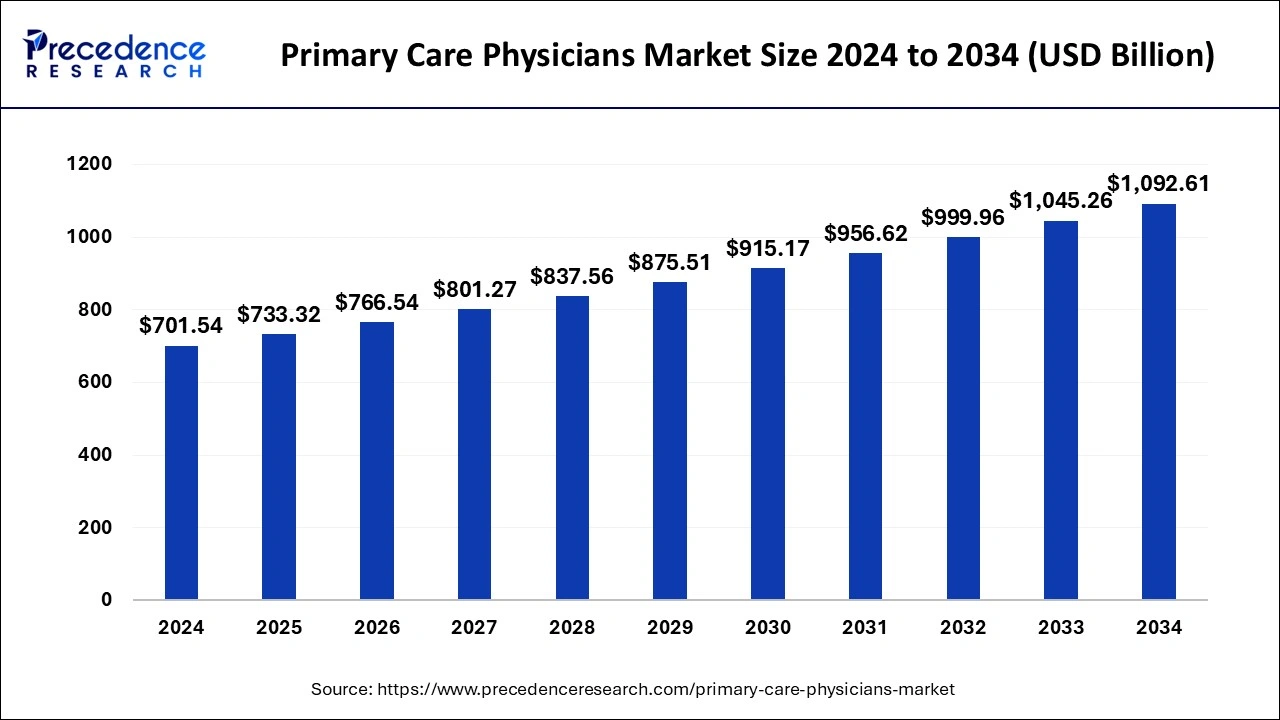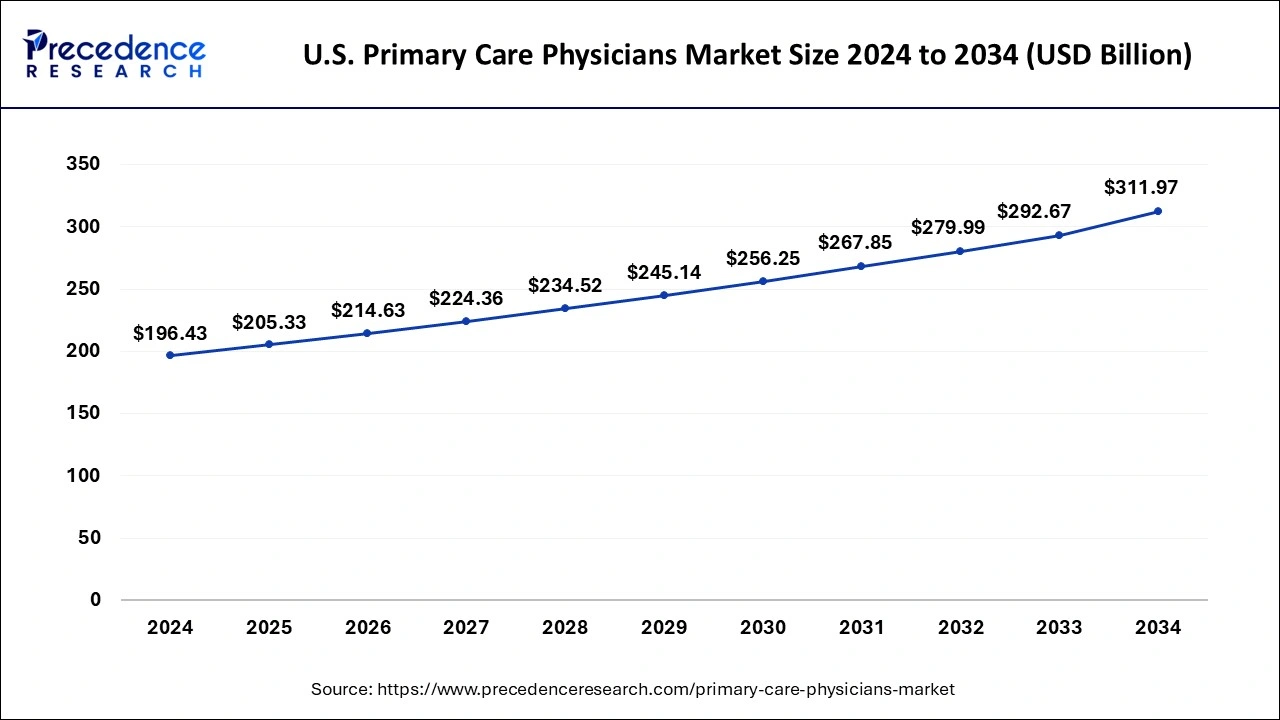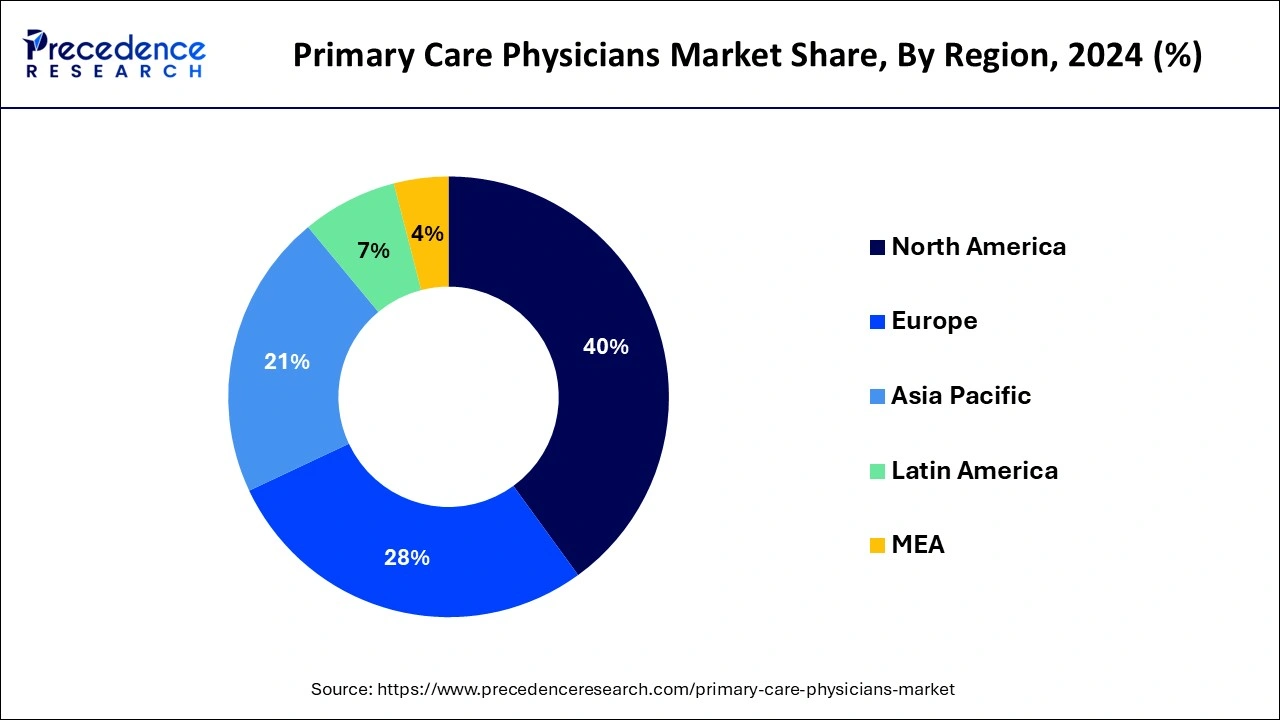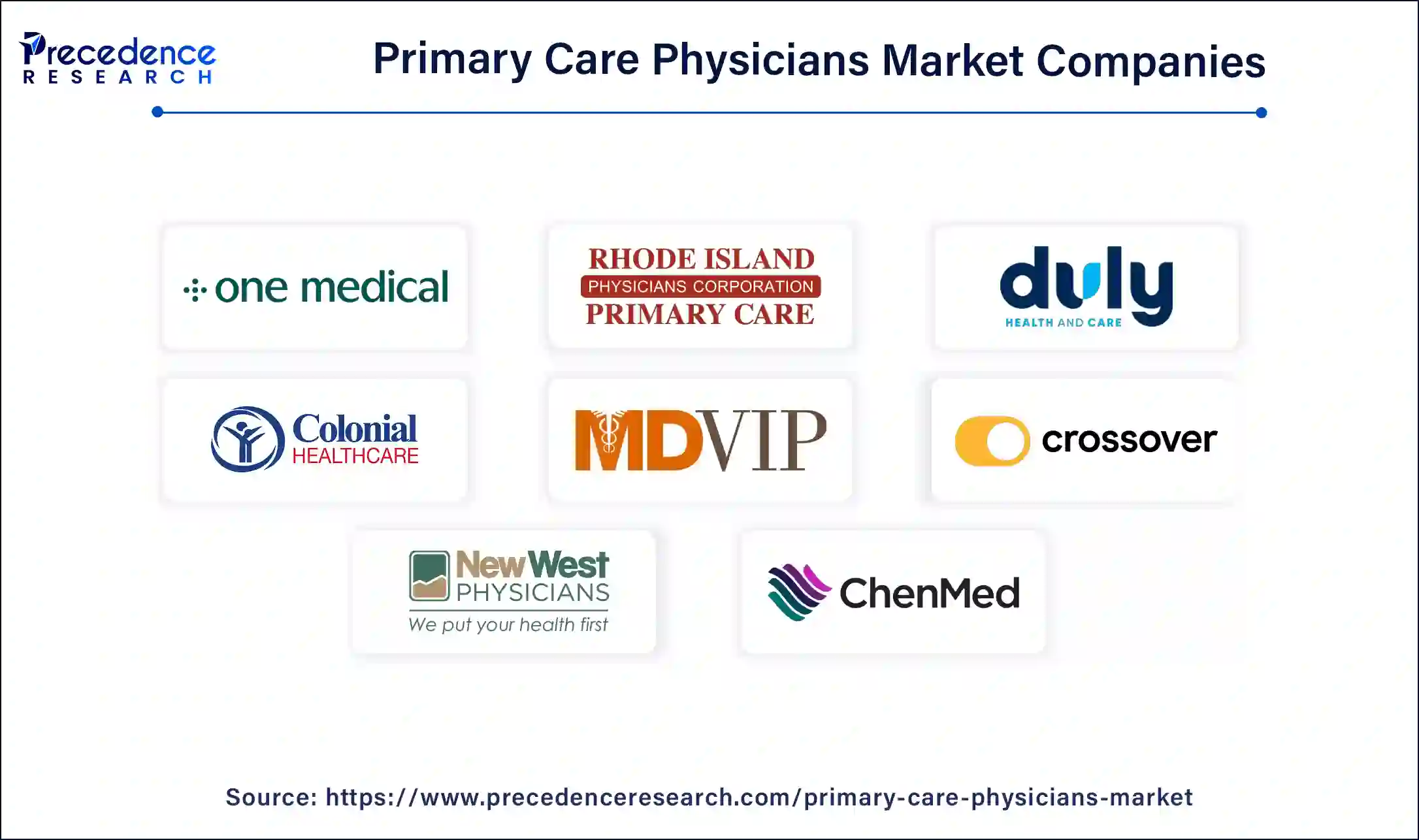January 2025
The global primary care physicians market size is calculated at USD 733.32 billion in 2025 and is forecasted to reach around USD 1092.61 billion by 2034, accelerating at a CAGR of 4.53% from 2025 to 2034. The North America primary care physicians market size surpassed USD 280.62 billion in 2024 and is expanding at a CAGR of 4.66% during the forecast period. The market sizing and forecasts are revenue-based (USD Million/Billion), with 2024 as the base year.
The global primary care physicians market size was accounted for USD 701.54 billion in 2024 and is anticipated to reach around USD 1092.61 billion by 2034, growing at a CAGR of 4.53% from 2025 to 2034. The market for primary care physicians is driven by the rising demand for quality care services and the growing awareness of early detection of diseases.

AI positively impacts the market for primary care physicians. AI helps automate various tasks for primary care physicians, allowing them to focus on other essential tasks. Moreover, AI streamlines time-consuming administrative tasks, helping PCPs in decision-making. The adoption of AI technologies in primary care facilities improves the care coordination of physicians. Overall, AI helps enhance primary care physicians' productivity by helping them provide quality care services to patients.
The U.S. primary care physicians market size was evaluated at USD 196.43 billion in 2024 and is predicted to be worth around USD 311.97 billion by 2034, rising at a CAGR of 4.73% from 2025 to 2034.

North America dominated the global primary care physicians market with the largest market share of 40% in 2024. The increased penetration of the primary care physicians in North America and increased demand for the primary care services has fueled the growth of the market. Moreover, the presence of huge aging population coupled with the growing prevalence of various chronic diseases has resulted in the increased demand for the primary care services. Moreover, the increased adoption of t6he family physicians has significantly contributed towards the market growth. As per the American Medical Association, around 39.5% of the primary care physicians were family physicians in US in 2017. Furthermore, the increased healthcare expenditure in US has supported the growth of the market. As per the CMS, in 2019, around 17.7% of the GDP was contributed by the healthcare spending in US and this is expected to reach at 19.7% by 2032. The increased health consciousness and the demand for the early detection of diseases has boosted the physician office visits. According to the US CDC, over 51% of the physician visits were made for the primary care in US in 2019. Therefore, the primary care services are the significant contributors to the North America healthcare industry. Moreover, the favorable reimbursement policies in the US has greatly contributed towards the growth of the primary care physicians market in North America. The rising prevalence of diabetes and surging number of new cancer cases in US is expected to further drive the demand for the primary care services and North America is expected to sustain its dominance throughout the forecast period.

Asia Pacific is estimated to be the most opportunistic market during the forecast period. The presence of huge population, rising prevalence of chronic diseases, rapidly growing geriatric population, and increasing healthcare expenditure are the major factors that are expected to foster the demand for primary care services in the region. According to the United Nations, around 80% of the global old age population will be living in the low and middle income countries by 2050. Moreover, the growing penetration of the general physicians in the countries like China and India is expected to have a positive impact of the growth of the Asia Pacific primary care physicians market in the upcoming future.
The primary care physicians market focuses on efficiently providing medical or healthcare services to patients of all age groups. Primary care physicians (PCPs) help to reduce the chances of hospitalizations. They are considered a key pillar of the healthcare system. PCPs are the first and the key point of contact for the patients. They help patients lead a healthy lifestyle and recommend medical professionals when they detect disease. The primary function of PCPs is to create long-term care plans for chronic patients. They can also assess a wide range of illnesses and work in various fields, such as primary care centers, emergency care centers, and pathology labs. They also conduct physical assessments, offer primary healthcare during emergencies, and give anesthesia before surgeries. PCPs also provide home care services and provide emotional support to their patients. The market is experiencing significant growth due to the rising awareness about the benefits of regular check-ups and consultations.
| Report Coverage | Details |
| Market Size in 2025 | USD 733.32 Billion |
| Market Size by 2034 | USD 1092.61 Billion |
| Growth Rate from 2025 to 2034 | CAGR of 4.53% |
| Largest Market | North America |
| Base Year | 2024 |
| Forecast Period | 2025 to 2034 |
| Segments Covered | Type, Region |
| Regions Covered | North America, Europe, Asia-Pacific, Latin America, and Middle East & Africa |
Aging Population
The demand for primary care services has increased in recent years, largely driven by an aging population. Older adults typically present with more complex health issues, necessitating frequent medical checkups and ongoing management of conditions. As these individuals require personalized care plans tailored to their unique health needs, the strain on primary care services increases. Moreover, the growing emphasis on preventive care and early disease detection boosts the demand for primary care services.
Shortage of Skilled Physicians
A notable shortage of skilled primary care physicians is affecting numerous regions, reducing access to essential healthcare services. This scarcity often leads to increased patient wait times, which can exacerbate health issues. Furthermore, the lack of availability of primary care facilities, especially in low- and medium-income countries, contributes to increased stress among other healthcare professionals. In addition to the shortage, primary care physicians face a significant administrative burden that further complicates their ability to provide quality care. This burden includes time-consuming tasks such as updating electronic health records (EHR), managing extensive insurance paperwork, and adhering to various regulatory compliance measures. These challenges underscore the urgent need for solutions to enhance primary care physicians' productivity and improve healthcare service efficiency.
Technological Advancements
Technological advancements create immense opportunities for primary care physicians. Innovations such as telehealth and electronic health records (EHR) are playing a crucial role in improving access to care. Telehealth allows patients to consult with healthcare providers remotely, making it easier for individuals in rural or underserved areas to receive necessary medical attention. Furthermore, EHR systems streamline patient information sharing among healthcare professionals, enhancing the efficiency and coordination of primary care practices.
The general practice, family physician, and geriatrics segment contributed the highest market share in 2024. This is attributed to the higher dependence general physicians and the family doctors from the Medicare beneficiaries. The family doctors are the first point of contact for the patients. It is estimated that around 20% of the physician visits in US is family physician visit. The family physician is the most important part of the primary care. Furthermore, this segment is expected to grow at a significant rate owing to the growing geriatric population and rising prevalence of chronic diseases among the population. The general physicians have specialized skills and knowledge that can help the physician to treat the patients for all medical conditions. The general physicians can also provide effective diagnosis of various medical ailments at the initial stage.

The primary care physicians market is highly unorganized and the market is moderately fragmented due to the presence of very few players across the globe. The growing number of participants in the global primary care physicians market is expected to boost the investments in the growth of the market across the globe. Moreover, various developmental strategies adopted by these market players such as new product launches, partnerships, collaborations, ad mergers are expected to drive the market growth in the foreseeable future. The market players are constantly seeking for establishing their dominance in the market, gaining competitive edge over others, and exploit the prevailing market opportunities.
By Type
By Geography
For inquiries regarding discounts, bulk purchases, or customization requests, please contact us at sales@precedenceresearch.com
No cookie-cutter, only authentic analysis – take the 1st step to become a Precedence Research client
January 2025
March 2025
January 2025
January 2024